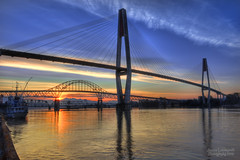 Image via Wikipedia
Image via Wikipedia
“Known carcinogens are found in drinking water as a direct consequence of the practice of chlorination”
FRANCIS T. MAYO, -DIRECTOR MUNICIPAL ENVIRONMENTAL RESEARCH LAB
“Cancer risk among people drinking chlorinated water is 93% higher than among those whose water does not contain chlorine.”
US COUNCIL OF ENVIRONMENTAL QUALITY
“Chlorine is the greatest crippler and killer of modern times. While it prevented epidemics of one disease, it was creating another. Two decades ago, after the start of chlorinating our drinking water in 1904, the present epidemic of heart trouble, cancer and senility began.”
DR. JOSEPH M. PRICE – SAGINAW HOSPITAL
“The National Academy of Sciences estimate that 200-1000 people die in the United States each year from cancers caused by ingesting the contaminants in water.”
JANET RALOFF-SCIENCE NEWS, VOLUME 130
“Drinking tap water that is chlorinated is hazardous if not deadly to your health.”
DR. MARTIN FOX –HEALTHY WATER FOR LONGER LIFE
“The cause of arteriosclerosis and resulting heart attacks and strokes is none other than the ubiquitous chlorine in our drinking water.”
DR. JOSEPH PRICE – AUTHOUR OF CORONARIES/CHOLESTEROL/CHLORINE
“Chlorine gas was used despicably during WWI. When the war was over, the use of chlorine was diverted to poisoning the germs in our drinking water. All water supplies throughout the country were chlorinated. The combination of chlorine and animal fats results in arteriosclerosis, heart attacks and death.”
DR. N.W. WALKER, D.S. – WATER CAN UNDERMINE YOUR HEALTH
“48-49 states are filing to adequately enforce existing drinking water regulations.”
JAMES ELDER –U.S. ENVIRONMENTAL PROTECTION AGENCY
FRANCIS T. MAYO, -DIRECTOR MUNICIPAL ENVIRONMENTAL RESEARCH LAB
“Cancer risk among people drinking chlorinated water is 93% higher than among those whose water does not contain chlorine.”
US COUNCIL OF ENVIRONMENTAL QUALITY
“Chlorine is the greatest crippler and killer of modern times. While it prevented epidemics of one disease, it was creating another. Two decades ago, after the start of chlorinating our drinking water in 1904, the present epidemic of heart trouble, cancer and senility began.”
DR. JOSEPH M. PRICE – SAGINAW HOSPITAL
“The National Academy of Sciences estimate that 200-1000 people die in the United States each year from cancers caused by ingesting the contaminants in water.”
JANET RALOFF-SCIENCE NEWS, VOLUME 130
“Drinking tap water that is chlorinated is hazardous if not deadly to your health.”
DR. MARTIN FOX –HEALTHY WATER FOR LONGER LIFE
“The cause of arteriosclerosis and resulting heart attacks and strokes is none other than the ubiquitous chlorine in our drinking water.”
DR. JOSEPH PRICE – AUTHOUR OF CORONARIES/CHOLESTEROL/CHLORINE
“Chlorine gas was used despicably during WWI. When the war was over, the use of chlorine was diverted to poisoning the germs in our drinking water. All water supplies throughout the country were chlorinated. The combination of chlorine and animal fats results in arteriosclerosis, heart attacks and death.”
DR. N.W. WALKER, D.S. – WATER CAN UNDERMINE YOUR HEALTH
“48-49 states are filing to adequately enforce existing drinking water regulations.”
JAMES ELDER –U.S. ENVIRONMENTAL PROTECTION AGENCY
Extend your life by 20 years or more.... (part 1)
WARNING: Tap Water is dangerous, do NOT consume!
Is Bottled Water an option?
Lab tests on 10 brands of bottled water detected 38 chemicals including bacteria, caffeine, the pain reliever acetaminophen, fertilizer, solvents, plastic-making chemicals and the radioactive element strontium. Though some probably came from tap water that some companies use for their bottled water, other contaminants probably leached from plastic bottles, the researchers said.
Lab tests on 10 brands of bottled water detected 38 chemicals including bacteria, caffeine, the pain reliever acetaminophen, fertilizer, solvents, plastic-making chemicals and the radioactive element strontium. Though some probably came from tap water that some companies use for their bottled water, other contaminants probably leached from plastic bottles, the researchers said.
WARNING: Bottled Water is dangerous, do NOT consume.
A Solution!!!!
KangenTM Water units start at ONLY $1280.
The average American spends $1500 a year on bottled water, save MONEY now and drink KangenTM Water.
The highest quality alkaline, hexagonal, anti-oxidant drinking water on the planet!
Shower units also available.
Take control of your health.
The average American spends $1500 a year on bottled water, save MONEY now and drink KangenTM Water.
The highest quality alkaline, hexagonal, anti-oxidant drinking water on the planet!
Shower units also available.
Take control of your health.
![Reblog this post [with Zemanta]](http://img.zemanta.com/reblog_e.png?x-id=a3f2af89-468e-4965-8094-2107516b2fc4)


![Reblog this post [with Zemanta]](http://img.zemanta.com/reblog_e.png?x-id=53511a10-3897-407f-a6ee-638e3a6cbf68)

![Reblog this post [with Zemanta]](http://img.zemanta.com/reblog_e.png?x-id=e0358441-7558-4ff4-8e52-8020d86badb9)
